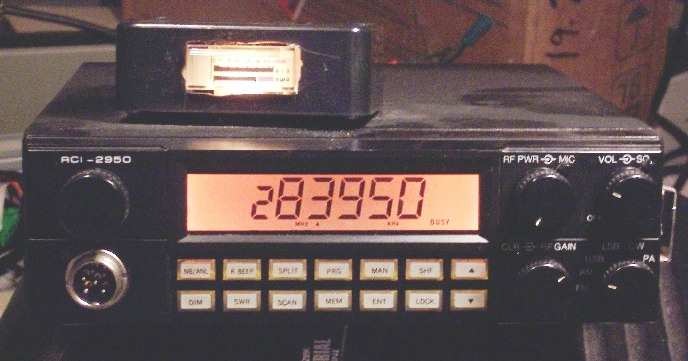

This is the RCI Communications model 2950. Another in the series of "10 meter" ham transceivers, which found a greater following among the CB crowd. Like the Uniden HR-2510, this radio contained an easy to modify microprocessor, which allowed expansion of frequency coverage to include the 11 meter band. Curiously, the radio, once modified, also traveled above the 10 meter band as well, up to 32 Mhz. What actual value this may have had was never really understood. In terms of features, this radio was equipped with the usual standard features of Volume, Squelch, R.F. & Mic Gain controls, Mode switch, and receive-only (RIT) Fine Tuning. This radio also expanded on the features found on the HR-2510, with the inclusion of memory channels, enhanced scanning capabilities, as well as the ability to operate on split frequencies. Like the 2510, the 2950 has selectable tuning steps with resolution down to 100 Hz. A 100 hz resolution is still too coarse for precise SSB tuning, so a receive-only Fine Tuning control is also included. Power output is adjustable on all modes. The display is very large and easy to read, and the push buttons are backlit, which made this radio a pleasure to operate while running mobile.
Performance wise though, this radio was not up to the HR-2510. Power output was close to 10 watts less on SSB, coming in at a nominal 35 watts. AM carrier power is recommended to not exceed 8 watts maximum to maintain full peak modulation percentage. The receiver, while varactor tuned to keep sensitivity consistent across the band, suffered from poor selectivity. The disappointing selectivity was further degraded by the noise blanker. Sensitivity was exceptional however, when the radio was aligned properly. The receiver AGC response curve was also a weak spot as strong local signals could overload and distort the receive audio forcing a manual R.F. gain reduction, which was not normally a problem. The noise blanker besides increasing bleed over problems, was also not as effective on pulse noise as it could have been. I also found that the 8 segment LCD meter (which due to the AGC issues, never showed more than 6 segments on receive) was not linear nor had a fine enough resolution, so I mounted an external analog meter (lighted too!) for more precise signal readings after making mods to correct the AGC.
Reliability was also not a strong suit for this radio, as it suffered from cold solder joints on the chassis mounted voltage regulators. I have had to repair several of these radios for this exact problem. Once modified, the radio usually played well without further incident. There were also modifications to improve both the noise blanker and the AGC. Early versions of this model also had some interesting Microprocessor/Display glitches. Sometimes the radio would power up with strange characters on the display, or it would run up on an unusual frequency.
These RCI radios also had a problem with spurious emissions during transmit. There was a lot of "crud" which accompanied the fundamental signal out of the radio. It seemed to be coming from the PLL's and their associated mixer circuits. Much of it could be tuned down with careful alignment (Which requires a spectrum analyzer), but not completely eliminated. They were also frequency dependant. You could minimize the spurs on one frequency, but they would increase again if you move a significant amount away from that frequency. The 2950's big brother the 2970 (Same basic radio with a self contained 100 watt power amplifier) was even worse. A 2970, operating on CB Channel 29, would throw out a large spur on 28.410 Mhz, which could be heard for miles, and was often mistaken for bootleggers. These would not be the radios to use on a base station, if you have neighbors trying to watch TV or listen to the FM stereo. The ultimate in RFI generation would be to run an RCI-2970, coupled to an Antron A-99 antenna. Your neighbors will love you!
I picked up my 2950 in the early 90's, and used it for several years in the mobile, before trading it for a Courier Centurion (Can't resist those classics!) On a scale of 1 to 10, I give this radio about a 5. The features and plusses of this radio, were offset by the reliability and performance issues. Due to my technical background, I was able to correct much of the "bad behavior" of this radio, but other people may not be able to achieve the same results, and their overall rating will likely be less.